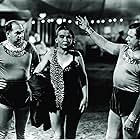Don't let people convince you that "Freaks" is a horror movie, because it isn't. It's actually a quite sad and sympathetic look at the way abnormalities were treated in the early part of the 20th century, and has direct parallels to the obsession with physical perfection causing eating disorders today. Tod Browning of course asks us to consider who are the bigger freaks: those with deformed bodies or those with deformed souls? The two "normal" people who are out to cheat and steal are monstrous, whereas the freaks are quite likable and charming. The ending is disturbing to be sure, but it's hard to condemn the freaks for acts that seem largely justified.
Is it a coincidence that in several shots showing Cleopatra reclining on a sofa, she appears to be deformed herself (in one shot it looks as if she has no legs). Has anybody else noticed this? "Freaks" was obviously way ahead of its time. There's a very interesting documentary on the DVD about its reception in 1932; it bombed and pretty much ruined Browning's career. Thank God that the general public is not allowed to be the final arbiter of a film's value. Think how many priceless films we would have lost by now if that were the case.
Grade: A

































